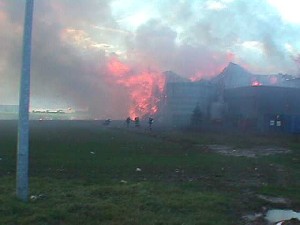On a Monday morning, a huge fire destroyed an archive warehouse comprising 2 cells, one measuring 3,630 m² and 14 m high (5 archive storage levels accessible by elevated walkways) the other 1,838 m² and 8.5 m high, with a metal structure separated by a fire wall remaining below the roof line. Employees working on the upper floors descended to the ground floor and unsuccessfully battled the blaze using 8 extinguishers. Once notified, fire-fighters entered the premises 10 min later and sprayed several fire sources on the ground floor. Since the warehouse had become engulfed in smoke, fire-fighters attempted to climb to the higher floors wearing self-breathing suits. When arriving on the first floor, they were forced to evacuate after being overwhelmed by a strong stack effect and a sudden flashover; the extremely hot fumes loaded with pyrolysis gas had self-ignited. The absence of storage cell lighting meant fire-fighters had to evacuate the zone in total darkness. Two strong explosions detonated following the rise in cell temperature, causing due to blast effects the abrupt opening of smoke exhaust hatches and the projection of screw jacks over a 20-m radius.
A vast hydraulic system was set up, requiring supplies delivered by lorry, given the shortfall in water reserves (120 m3). First responders only had access to one of the site’s 2 fire hydrants, whose installation on the same line produced head losses. The large cell collapsed within an hour; the fire wall gave way shortly thereafter, crushed by the caved-in roof. The archived papers were dispersed by strong wind gusts (100 km/hour) pushing the plume of smoke towards the city. The thermal radiation emanating was weak 50 m downwind of the fire, which would take 4 days to bring under control. The operator stopped all onsite activity. The automatic extinction system had only been partially operable, as the motor on the main pump could never start. The automatic smoke outlets were not equipped with fuses under the effect of intense heat. The narrow corridors and access paths, in addition to the storage layout, further complicated the emergency response. According to the Classified Facilities Inspectorate, the resumption of activity on the morning of the accident created a sufficient draught to suddenly ignite a smouldering fire.
A preliminary judicial investigation was opened for involuntary destruction of another’s property (i.e. clients’ archives). The operator was indicted on 13th November 2009 but appealed this decision, which wound up being overturned by the Amiens Court of Appeals. The Court’s ruling considered that noncompliance with respect to the permit (building’s fire resistance, smoke removal system, lack of fire-related training, etc.) had no direct bearing on the involuntary outbreak of fire, which had resulted from an electrical problem.
Download the detailed report in .pdf format (103 Kb)






